Thank you for visiting! By the way… any links on this page that lead to products on Amazon and other stores/partners are affiliate links Aquarium Store Depot earns a commission if you make a purchase.
Koi Betta Fish (also known as a marble betta) are a newer variant of Betta and have the striking colors. They come in many colors and are very popular among Betta Fish enthusiasts. This article will explain the origins, history and care involved with this striking betta variation.
Species Overview
The Koi Betta is considered a fancy variety of your traditional betta fish. What really means them stand out is their coloration.
| Scientific Name | Betta splendens |
| Common Name (Species) | Koi Betta, Marble Betta |
| Family | Osphronemidae |
| Origin | Asia |
| Diet | Omnivore |
| Care Level | Easy |
| Activity | Active, social |
| Size | Up to 3 inches |
| Lifespan | 2-3 years |
| Temperament | Peaceful |
| Tank Level | All Areas |
| Minimum Tank Size | 5 Gallons |
| Temperature Range | 70 – 80 Degrees F |
| pH Range | 7 pH |
| Filtration/Flow Rate | Clam to Moderate |
| Water Type | Freshwater |
| Breeding | Egg-layers, easy to breed |
| Compatibility | Peaceful community species |
| Ok For Planted Tanks? | Yes |
Origins And Habitat
Koi Bettas originated from Orville Gulley, a Betta breeder. Both an unusual and intriguing story surrounds these fish. He originally started breeding them in peanut butter jars while in prison!
The Marble Betta was born from a failed attempt at trying to create the first butterfly black betta. It was discovered that it had the marble gene and after examining this new discovery, Gully submitted some of these new Betta variants to the International Betta Congress, well-known hobbyists, and book authors who have written about Betta fish.
The Marble Betta became a recognized Betta breed and took on the commercial moniker “Koi Betta” as a trading name since the Betta’s colors and shine resemble that of Koi fish.
There are no Koi Bettas in the wild as a result of their origins. They are the result of a genetic mutation. The mutation is a jumping gene, a DNA sequence that can change its position within the genome. As a result, the colors of the Koi Betta can change over time as they age.
Appearance (What Do Koi Betta Fish Look Like?)
The Koi Betta is a Palkat Betta variety so their shape exhibits a Palkat, however it’s their colors that really stand out. The best way to explain how they look like is to go over all the various varieties of koi bettas.
Types
There are 6 types of koi bettas you will usually see store online or in specialty stores. They are the following:
- Fancy
- Galaxy
- Candy
- Tiger
- Nemo Palkat
- Samurai
Fancy
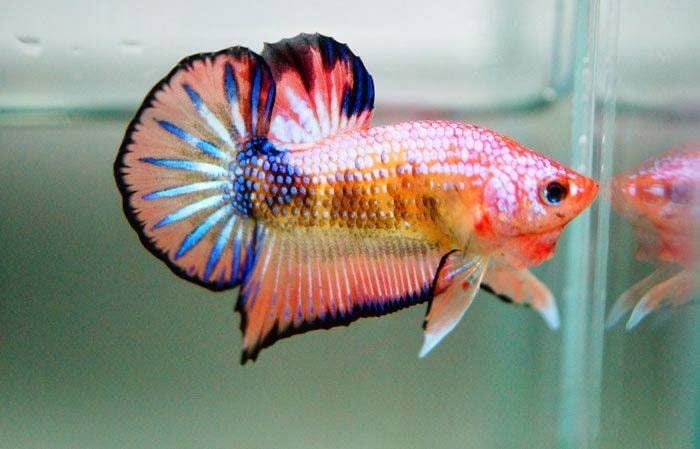
A Fancy Marble Betta is a fish that exhibits at minimum 3 difference colors
Galaxy
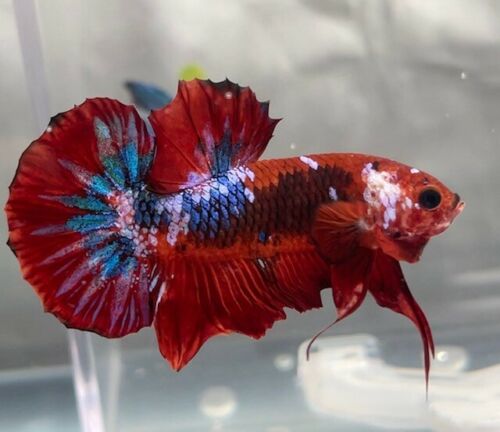
A Galaxy Koi Betta is the most common type you will find. They get the name Galaxy from their iridescent scaling that shimmer when they are moving
Candy
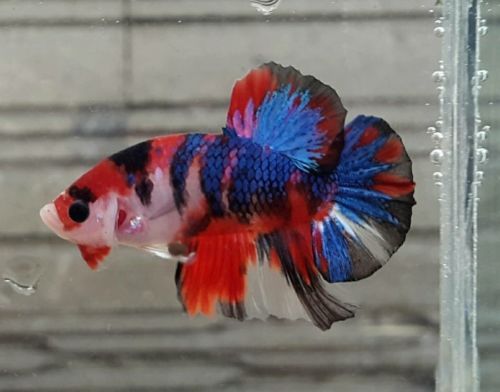
Candy Koi Bettas are characterized by their black, red, blue or yellow colors. The name comes from looking like a candy treat. Personally, I like to call them ice cream bettas because they remind of sorbert and ice cream bars.
Tiger
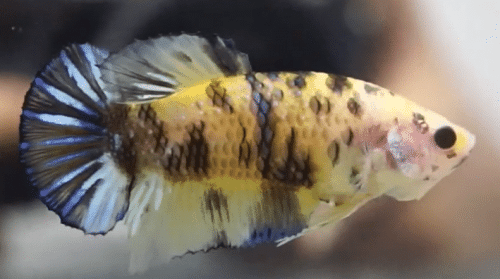
A tiger betta has a striking yellow body with black or blue colors to compliment it.
Nemo

The nemo betta is a marble with orange red and blacks they generally are the second most popular koi betta you will find
Samurai
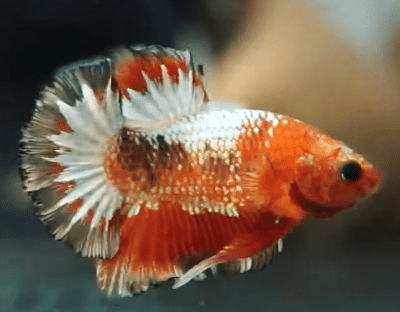
A Samurai Koi Betta is the rarest of them all. It has the desired dragon scaling with the marble. They come in a variety of colors.
Note that there can be combined varieties in the trade. it’s not uncommon to find a Candy Galaxy Betta has an example. You will also find fancy tail type varieties. Crowntails and halfmoons tend to be the most common. The fancier the fins, the more delicate your betta will be so keep this in mind.
How Big Can They Get?
Koi bettas are no different than traditional bettas when it comes to size. They can grow up to 3 inches in length.
Lifespan
Just like other Betta fish, the koi betta will have an average lifespan of 2-3 years. Optimal water conditions, low stress, and great nutrition will extend lifespan and quality of life.
Temperament And Activity Level
Most Koi Betta fall into the Plakat Betta variety. These betta fish are closer to natural bettas in the wild. As a result, they are more lively and athletic to their fancy finned brothers and sisters. This also makes them more aggressive than the fancy style varieties. This opens them up to larger aquariums and community tanks as they are able to hold their own with more active fish species.
What Are Good Tank Mates For Them?
When looking for good tanks mates for your Koi Betta, it is no different than any other betta. You are looking for tank mates that are peaceful, keep to themselves, and enjoy a planted tank setup.
Good Tank Mates (Species and Inverts)
The following are excellent choices for your Koi Betta:
- Dull looking tetras like the black neon tetras
- Peaceful barbs like the cherry barb
- Freshwater shrimp – preferably larger like Amano shrimp
- Dwarf catfish like corydoras
- Snails
Species To Avoid
You want to avoid any fish that is semi-aggressive to aggressive. Any fish that can fit your bettas head in its mouth should also be avoided. Examples of fish to avoid would be:
- Cichlids
- Aggresive barbs like tiger barbs
- Fish with long colorful fins
What Do They Eat?
There is no specialized diet for a Koi Betta. They are no different than a traditional betta. The same hierarchy is involved with frozen>pellet>flake food. Fish can get bored of eating the same food though. Let’s look at what you can feed your Koi Betta.
What To Feed Them
I generally don’t work with flake food even with bettas. I work with pellet betta fish food at minimum and my go to is Northfin. If I’m going for freeze dried,I prefer feeding my bettas blackworms and soaking with VitaChem to provide extra nutrients for my Betta’s immune system.
If you are looking for live foods, check with your local fish stores. You might get lucky and find one that offers live blackworms. These are great for bettas. Bloodworms are more available, but blackworms are simply fantastic if you can find them.
You can order live blackworms online in bulk if you are extra brave with having worms shipped to you 😅. Brine shrimp can also work, but lack the nutrient punch that blackworms provide for these freshwater fish.
Your Betta is also an algae eater, so they will also accept algae wafers.
How To Set Up A Suitable Tank (Tank Requirements)
Here’s what you need to keep in mind when setting up your koi bettas’ fish tanks. We also included a video from our YouTube channel for more visuals. Please sure to subscribe to our channel if you like our content. We post new videos every week.
What Is A Proper Tank Size?
It would be best to have a new tank of at least 2.5 to 5 gallons for your koi betta fish. Please do not make the mistake of putting these long finned fish in a small bowl, like children’s films and comics; this will stress them out and decrease their lifespan significantly, and they already have a short lifespan.
Heater
Koi bettas originate in warm Southeast Asian regions such as Thailand and Indonesia. As such, it’s important to provide a submersible heater in their tank that will allow the water to remain between 76 and 80 degrees F.
Be careful not to let the temperature get too high — this might cause your koi bettas to age faster. On the other hand, if the temperature is too low, your fish are at greater risk of infections.
So what do you do? Choose a heater that comes with a thermostat. That way, you don’t have to worry about upsetting the balance.
Decor
The decor you choose for your koi betta should be smooth to not hurt your fish. If you’re thinking of installing artificial plants, go for those made of silk. Also, consider installing some tunnels and caves for your koi bettas to hide in.
Live Aquarium Plants
The natural habitat of koi betta fish is heavily vegetated. As such, you should provide many plants which your fish can use as hiding or sleeping spots. This is particularly important if you put them in a community tank.
Substrates
Gravel and sand are the best substrate choices for koi bettas. However, it would help if you aimed to provide a substrate that promotes the growth of your chosen live plants like an active soil.
Lighting
The koi bettas follow a similar schedule as humans; they sleep at night and wake up during the day. Therefore, when it comes to the lighting conditions, you don’t need to put extra effort into creating artificial light for your tank. All you need to do is turn off the lights before heading off to bed.
Tank Position
You must be careful with where you place your koi bettas’ tank. If it’s too close to the window, the tank will heat up or cool down too quickly (depending on the season). For the same reasons, avoid putting your koi bettas near sources of heat, such as radiators.
Additionally, place the tank on a flat and stable surface.
Water Quality And Tank Conditions
Water quality is very important for your Koi to be healthy and avoid common fish diseases. Let’s dive into it more below.
Which Filters Are Most Suitable For This Type of Fish?
Koi betta fish need gentle filters in their aquarium to emulate their natural habitat. A sponge filter can work great, but may not provide enough filtration in a full planted setup. Adjustable filters are best as this allows for optimal current creation. Power filters usually can be adjusted for lower flow and you can place a sponge on the intake to prevent the filter from suck the fins of your Betta.
Whatever you do, though, don’t skip out on the filter; it keeps the aquarium water clean and prevents the buildup of toxic waste.
Water Conditions – Parameters
To successfully sustain a Betta fish ecosystem, you must keep certain parameters in check. Here’s what you should know:
Water Temperature
For Koi Bettas, the ideal water temperature should be around 76 to 80 degrees Fahrenheit. The waters in Vietnam and Indonesia are mainly warm with neutral and slightly acidic conditions. And, to allow the fish to rest and feed on, make sure you change the water at least twice a month and keep some live plants around.
Water Hardness And pH Range
Koi betta fishes are used to living in soft water conditions. For pH, you should keep it slightly acidic from 6.0 to 8.0 in the aquarium.
Not only that, you need to ensure that they can swim up to the aquarium surface to take in oxygen. Koi bettas have respiratory organs using which they can convert oxygen from the air into energy. And so, if the oxygen saturation within the tank is low, they should be able to swim to the surface to obtain it.
Breeding
Breeding Betta Fish is a separate post in itself. If you’re looking to breed healthy Marble Bettas, be ready for a slow and nerve-wracking journey. These fishes are easy to breed, but if you want a specific color pattern or variation, you’re going to have to be very selective of the partners selected for the Koi Betta.
To keep this all in one article, I’m going to supply this great video from Ale’s GuppiLine. I’ll provide some bullet points below to summarize
The video above covers breeding in general. With Koi Bettas, ss their genes are said to be codominant, pairing them with solid fishes will rarely spawn fishes with unique marble patterns. Almost nine out of 10 times, you are likely to get solid-colored offspring.
Similarly, if you cross breed two Marble Bettas, it doesn’t necessarily mean your breeding pair will produce a tank full of marble offspring. In fact, the possibilities are endless. Crossing marble genes with one another will give you a range of fry from dark or light solid colors to marbles and sometimes even butterflies.
When a male koi betta fish is ready to mate, he will start to build bubble nests (a healthy male will also do this sometimes, even when not in mating mode). The male might get aggressive towards a female koi betta fish when she tries to approach his bubble nest.
How to Distinguish between Male and Female
How can you tell the gender of your betta fish? For starters, looking at the fins is one way of differentiating male betta from females.
Female betta fish tend to have smaller fins (by which we mean thinner and sometimes shorter fins) than their male counterparts. However, the fins of females can also be of the same size in length, but male bettas will always have bulkier ventral fins.
Moreover, the physique of the female betta fish is more streamlined than the male koi betta. You can also look for an egg spot (white lump) which adult female betta fish develop near their ventral fins. Don’t be alarmed if your female Betta doesn’t have one; it simply suggests that they are still very young.
Furthermore, the body color of male betta fish is comparatively brighter than that of females. Male koi betta tends to have larger heads than females, and they have a curved shape which makes their body appear bulky as opposed to the streamlined look of females.
Where To Buy
You will probably find koi bettas listed as an exotic type at your local pet stores. If not, you might be able to order them online.
However, these beautiful fish really deserve to be seen upfront before you purchase them, so we’d suggest finding pet stores where you can do that or a what you see is what you get (WYSIWYG) vendor. You can click on the link below to view WYSWIYG Betta Fish available, which includes Koi Bettas!
Use Coupon Code ASDFISH at Checkout
Betta Fish are one of the most beautiful varieties of freshwater fish available in the hobby. Easy to care for with plenty of varieties!
Koi Bettas are one of the more expensive types of Betta Fish. They can go up to $65 apiece, with the lowest price usually being around $30. The price might be even higher if you opt for a breeder quality male.
Closing Thoughts
The current popularity of bettas is undeniable. Their wide array of color options and their distinct behavioral traits truly set them apart, as does their hardy build. But the ease of caring for these beautiful fish is what makes them so special. If you are looking for a general overview of Bettas, check out this article.
Got any questions about Koi Bettas? Leave a comment below and let’s start a conversation!
- About the Author
- Latest Posts
I’m thrilled that you found Aquarium Store Depot! Here you’ll find information on fish, aquariums, and all things aquatics related. I’m a hobbyist (being doing this since I was 11) and here to help other hobbyists thrive with their aquariums! I adhere to a high quality Editorial Process and Review products with real life field usage and practical analysis.


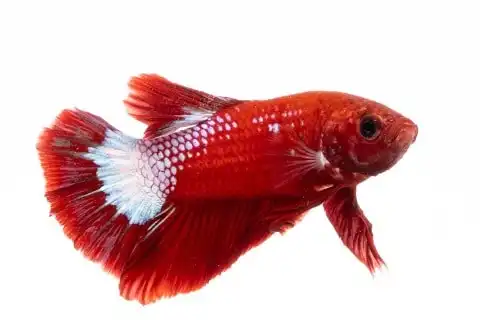




Hello,
I have a 75 ga community tank with gupppies, plates, shrimp, Cory’s, pleco and snails. I understand this may not be the best choose for the beta but was wondering if I got a second tank if I’m able to put more than. One betta in as I heard maybe multiple females? They’re just so colorful it would be gorgeous but don’t want to do any harm. What are your thoughts? Thanks
Hi there. Harems can be kept. I actually have an article that talks about it, Here is the article.
Hello Mark. Such a well written article, much appreciated. I just bought 5 ad 10 G tanks, the 5 is upright and the 10 is long and more shallow. One Koi better in the 5G, and a stars and stripes half moon in the 10G. I intend to put some of the tank mates you mention in each aquarium.
What would be the best plants for these tanks, and is there an advantage in using almond leaves and better resting decor (stuck to the glass)? How many tank mates for each. I do like black neon tetras and corydoras – albino or another color?
Many thanks for your advice.
Hy NJG. I actually have an article all about plants for betta fish. Check it out here. Almond leaves are good for tennis and healthy for a betta fish. You can also get supplements if you don’t want to use the leaves.
Hey, I got a Nemo Koi recently, and he won’t stop flaring at the sides of the tank. I have a Java Fern in there, and need to keep the lights on for it. What do I do? Replant, move more decor to the sides so he can’t see himself?
Hi Riley,
Flaring is normal for a betta when he sees his reflection. It’s not too much of a problem. You can mitigate the issue with more plants or a background. More plants need the area he likes to flare will help mitigate. If you go with an aquarium background, try going with a lighter color as a dark color is easier for them to see themselves.
Hello mark..I’m not computer savvy..but I have bred most tropical fish and Bettas for years..my first tropical fish was a pair of swordtail fish..that ..when I was 9 yrs old..the first breeder.of discus….was a man named..wattly…who .I the 1950s..he was my dad’s friend in n.y..ive been a breeder of angels cichlids..etc..been there done .that..I’m too old too..keep the 65..custom tank..that had every thing .. living together. 🤗🙄…did the breeding of Bettas.. for years..a million vases. Lol 🤣 too much for me.now..im not techno but I’ll try..very picky with perfect finage . and color..what happens when you try to breed..a male platinum crowntail to a colorful..female koi Betta?
Hi There. I’m not sure. I don’t know anyone who has attempted. Maybe you can make your own designer betta bred ^_^